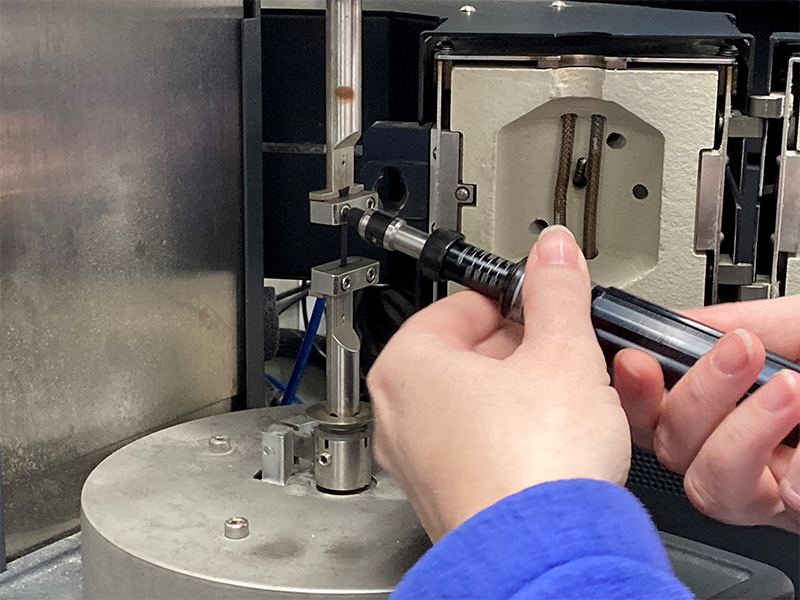Dynamic Mechanical Analysis (DMA) is an indispensable tool in the arsenal of product and polymer engineers and scientists. Unlike static testing methods, DMA analyzes the viscoelastic
properties of materials, providing better insight into their performance under different conditions. We spoke with Supervisor and Test Engineer
Amanda Cool at our Akron rubber and plastics testing lab to discuss the capabilities and applications of DMA.
Can you provide some details on what DMA measures, how it’s measured, and what distinguishes it from a standard tensile test?
DMA measures the viscoelastic properties of materials, unlike a standard tensile test that assesses tensile stress and strength under a unidirectional force. While tensile tests involve samples like dumbbells or
O-rings, DMA uses oscillating deformation across varying conditions (temperature, stress, time, strain) to analyze how materials behave as solids and liquids.
In our lab, we often focus on
polymers, which exhibit time-temperature dependent viscoelasticity. These materials can shift between rigid and soft states based on force duration and temperature. During DMA testing, we apply oscillating strain and measure the resulting force while changing the temperature. This process allows us to determine the Storage Modulus, indicating energy storage capacity, the Loss Modulus, reflecting energy dissipation, and Tan Delta, which shows the relationship between elastic and viscous behavior.
What key viscoelastic properties does advanced DMA characterization reveal, and what important details are necessary for accurate data interpretation?
Dynamic Mechanical Analysis reveals a spectrum of essential viscoelastic properties, helping us understand how materials behave mechanically under different conditions.
Specifically, DMA can reveal:
- Stress-Relaxation Response: Internal stress decreases over time at constant strain.
- Creep Response: Material deforms over time under constant load.
- Complex Modulus (E* or G*): Overall resistance to deformation, including elastic and viscous components.
- Loss Modulus (E'' or G''): Energy dissipation during deformation, indicating internal friction.
- Storage Modulus (E' or G'): Material's ability to store elastic energy and recover, reflecting stiffness.
- Tan Delta (tan δ): Ratio of loss to storage modulus indicates damping characteristics; a peak relates to glass transition temperature.
- Glass Transition Temperature (Tg): Range where polymers transition from hard to flexible, affecting viscoelastic properties.
- Crosslinking and Filler Behaviors: Insights into polymer network crosslinking and filler effects on mechanical response.
When it comes to getting accurate data, the thing to keep in mind is understanding the testing goals. What specific insights about how the material behaves or performs are needed? Application considerations play a big role in choosing the right DMA test parameters and which key properties to examine.
Where do you see the most useful application for DMA testing currently?
Currently, one of the most impactful applications of DMA testing lies within the tire industry. Tire performance depends on the complex viscoelastic properties of its rubber compounds, and DMA is an effective tool for analyzing and predicting these characteristics.
Dry traction is often related to the tire compound's stiffness at higher temperatures and frequencies, indicated by the storage modulus. Rolling resistance, crucial for fuel efficiency, is linked to the energy lost in the tire material during deformation, as shown by the loss modulus. Snow traction can be evaluated by looking at the tan delta peak at low temperatures, which indicates how the material performs in cold conditions. Wet traction and cornering performance depend on how the tire compound reacts elastically and viscously under different temperatures and stress conditions, which can be effectively assessed by DMA.
DMA effectively simulates the stresses and temperature changes that tires face, helping engineers develop safer and more efficient tire compounds.
How can advanced DMA protocols help us analyze current compound performance and also predict long-term behavior and failure under real-world conditions (in tires, for example)?
DMA provides a comprehensive method for understanding
tire compound performance by measuring viscoelastic response under driving-like stress and temperature. Analyzing storage and loss modulus correlates with dry traction, cornering, and rolling resistance. Tan delta predicts snow traction and wet grip.
This characterization helps OEMs make informed tire selections, allowing DMA to serve as a cost-effective screening tool, minimizing the need for extensive on-vehicle testing. Manufacturers can efficiently eliminate non-compliant compounds early in development.
Additionally, DMA can predict long-term behavior through time-temperature superposition (TTS
), linking viscoelastic properties to time and temperature. This enables the creation of master curves predicting tire behavior under various conditions, aiding in improved durability and reliability over time.
What promising novel applications of advanced DMA could speed up the development of new compounds and customize material properties for future needs?
While I don't have first-hand research on this subject, recent developments in DMA suggest new applications that could enhance polymer compound development and improve control over material properties.
A key area is real-time monitoring of polymerization and curing. By incorporating miniaturized DMA sensors into reactors, we can receive immediate feedback on the material's changing viscoelastic properties. This in-situ monitoring enables precise control over reaction conditions, allowing for targeted molecular weights and crosslink densities.
Further advancements in DMA technology will lead to the creation of novel polymer compounds with customized properties.
Dynamic Mechanical Analysis offers a powerful lens through which to understand the complex viscoelastic behavior of polymers. DMA offers essential insights for product and polymer engineers in demanding industries, such as tire manufacturing, aiding in material selection, performance prediction, and innovation acceleration. Understanding DMA testing and its advanced capabilities can help us maximize the potential of polymeric materials for future applications.
If you or your team are ready to gain deeper insight into your materials with DMA, contact Amanda today to discuss your specific testing needs.
